Every year, Gallup asks Americans to estimate the amount of time they spend exercising at different levels of intensity. The results show that nearly half of Americans work out regularly and vigorously, while slightly more than half do not. Which Americans are most likely to work out? The answers yield a few surprises.
Overall Results
Gallup's annual health survey asks Americans how many days each week they take part in "vigorous sports or physical activities for at least 20 minutes that cause large increases in breathing or heart rate" or in "moderate sports or recreational activities that cause slight increases in breathing or heart rate, such as walking, gardening, or other similar activities."
The results of these two questions are combined into four different categories in Gallup's exercise index:
- High: Adults who engage in vigorous activities three to seven days a week
- Medium: Adults who take part in vigorous physical activities one or two days a week
- Low: Adults who are rarely involved in vigorous activities but do partake in moderate activities three to seven days a week
- Sedentary: Adults who rarely take part in any vigorous or moderate activities
To better understand which groups of Americans are most likely to work out frequently and vigorously, Gallup combined the results of its last three surveys, conducted from November 2003 though November 2005. Overall, 29% of Americans fall into the "high" exercise category, while an additional 19% fall into the "medium" category. More than half of Americans fall into the "low" (23%) or "sedentary" (28%) exercise categories.
Men, Younger Americans More Inclined to Exercise Regularly
The data show that men are much more likely than women to say they exercise or engage in vigorous sports or activities on a regular basis. Fifty-six percent of men belong in the high (33%) or medium (23%) exercise categories, compared with only 42% of women (26% high, 16% medium). Nearly 6 in 10 women fall into the low (26%) or sedentary (32%) exercise groups.
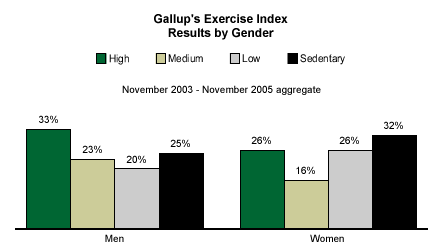
The likelihood to exercise frequently and vigorously is most common among younger Americans and decreases substantially with age. Two in three adults aged 18 to 29 fall into the high or medium exercise categories. This compares with 52% of 30- to 49-year-olds, 41% of 50- to 64-year-olds, and 32% of adults aged 65 and older.
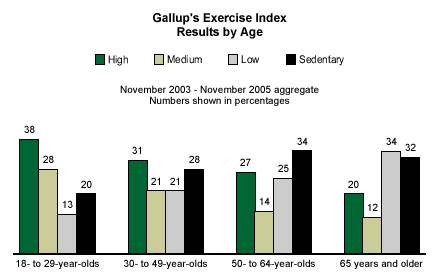
Interestingly, men are consistently more likely than women to say they exercise frequently and vigorously, regardless of the respondent's age, with men aged 18 to 29 the most likely group to work out.
Good Health Means More Exercise?
Healthier Americans are more likely to say they participate in frequent, vigorous exercise than those who are not as healthy. A majority of Americans who describe their physical health as excellent or good fall into the high (32%) or medium (21%) exercise categories, while only 3 in 10 adults who describe their health as only fair or poor do so (17% high, 13% medium). Nearly 7 in 10 adults who say their health is only fair or poor are in the low (23%) or sedentary (46%) groupings.
The direction of this relationship is not clear. Americans who are in poor health may not have the opportunity or ability to exercise as much as those in good health. It may also be, of course, that the exercise itself causes the differences in health situations.
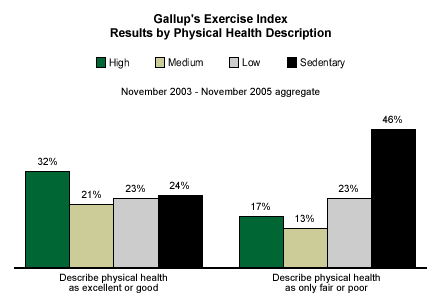
Weight Affects Exercise Habits
Americans who describe themselves as overweight are much less likely to exercise frequently and vigorously than those who describe their weight as about right or underweight. Roughly 4 in 10 overweight adults fall into the high (22%) or medium (18%) exercise categories, while a majority of adults who are underweight or "about right" are in the high (34%) or medium (20%) range. Nearly 6 in 10 overweight adults fall into the low or sedentary groups.
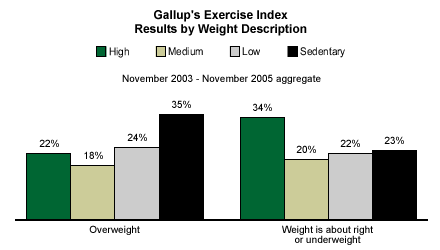
Exercise Habits of Smokers
Gallup finds only modest variations in the exercise habits of smokers and nonsmokers. Forty-six percent of smokers -- and 49% of non-smokers -- fall into the high or medium exercise groups.
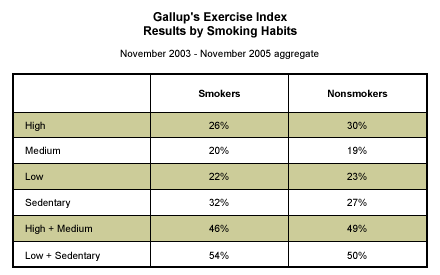
More You Earn, More You Exercise?
Americans residing in higher income households are more likely than those living in lower income households to exercise frequently. Among adults earning less than $30,000 per year, only about 4 in 10 belong in the high (24%) or medium (17%) exercise categories, while nearly half of adults earning between $30,000 and $75,000 exercise at the high or medium levels. Fifty-six percent of those earning $75,000 or more per year exercise at this level.
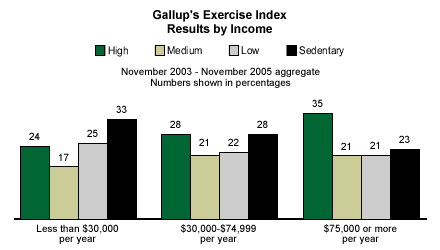
*Results are based on telephone interviews with 3,027 national adults, aged 18 and older, conducted Nov. 3-5, 2003, Nov. 7-10, 2004, and Nov. 7-10, 2005. For results based on the total sample of national adults, one can say with 95% confidence that the margin of sampling error is ±2 percentage points. In addition to sampling error, question wording and practical difficulties in conducting surveys can introduce error or bias into the findings of public opinion polls.
